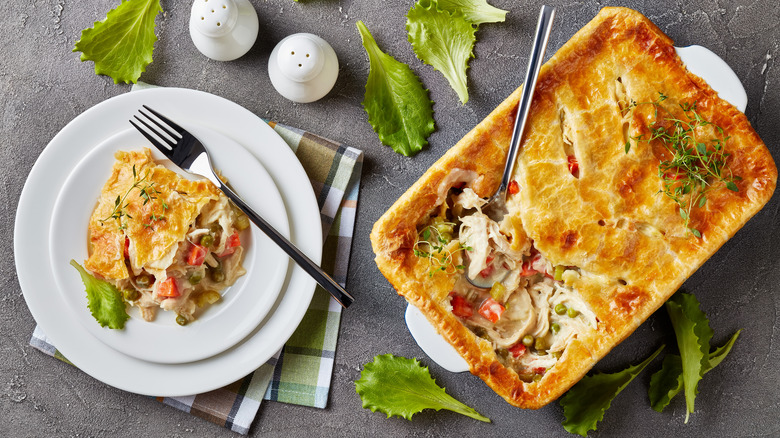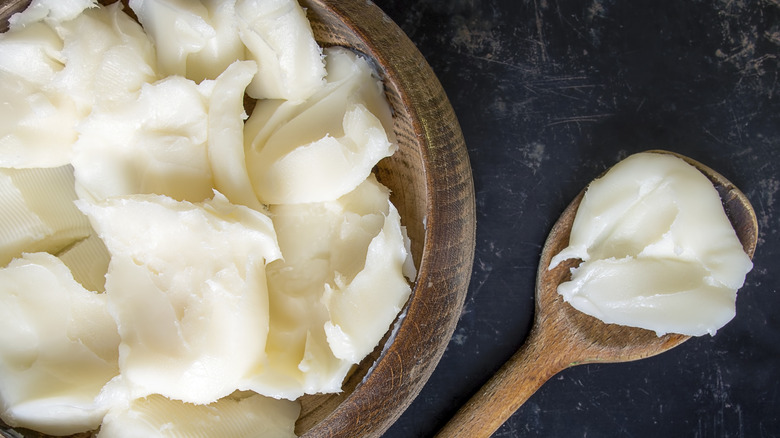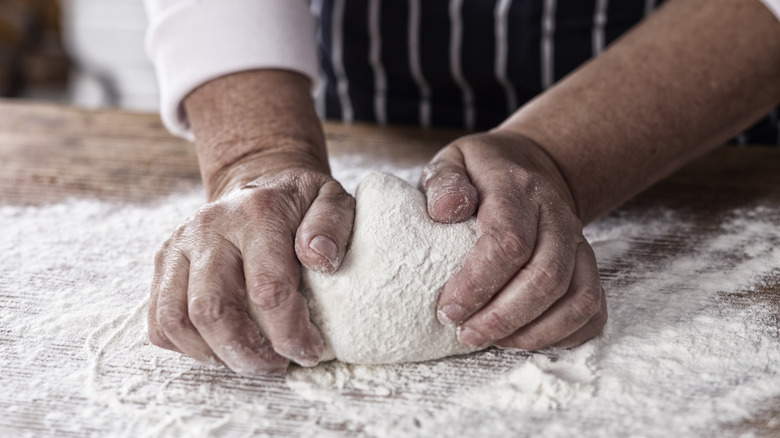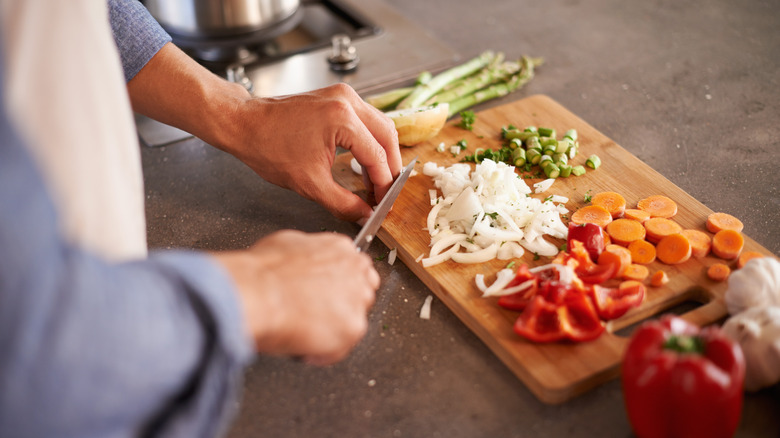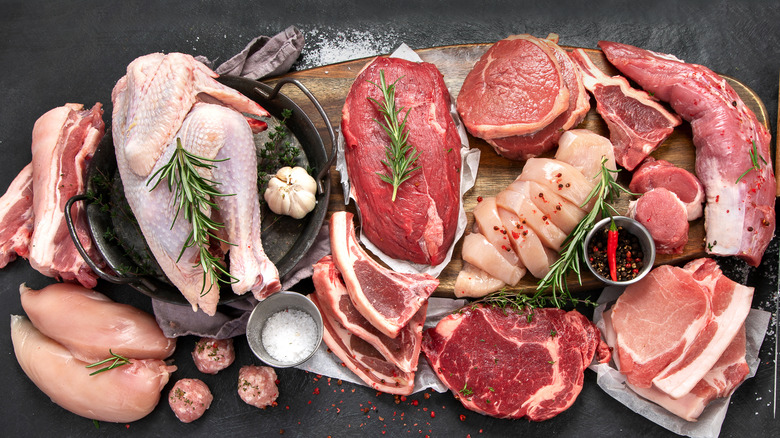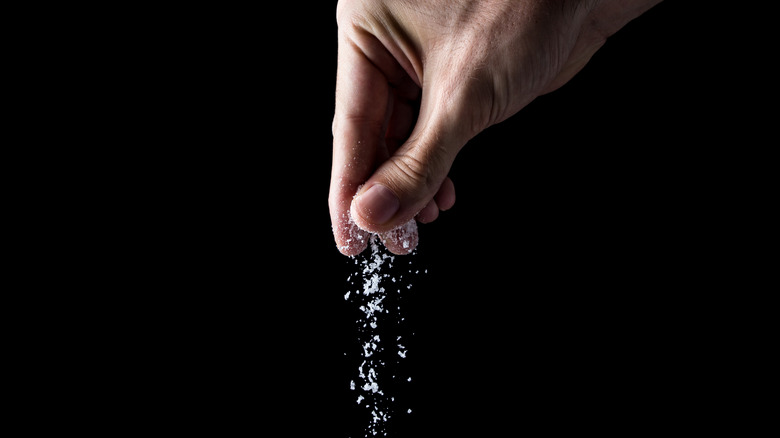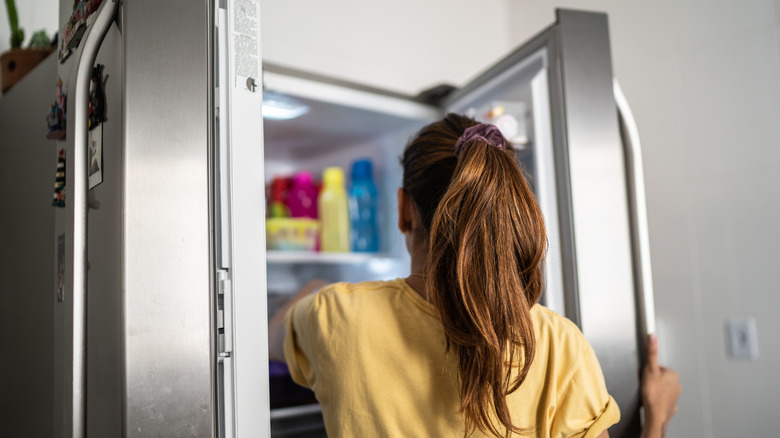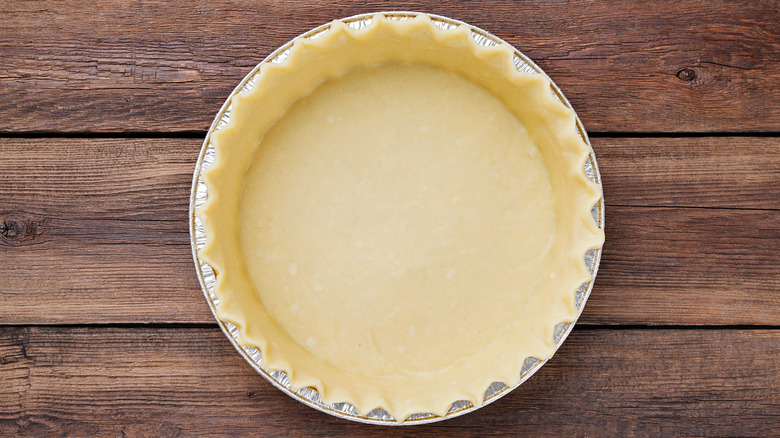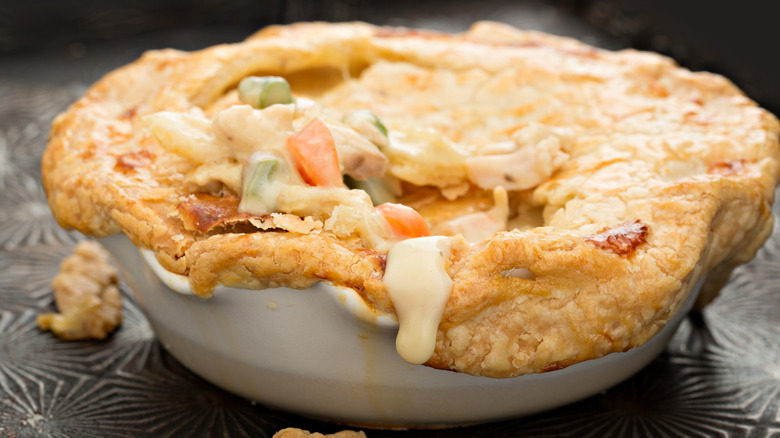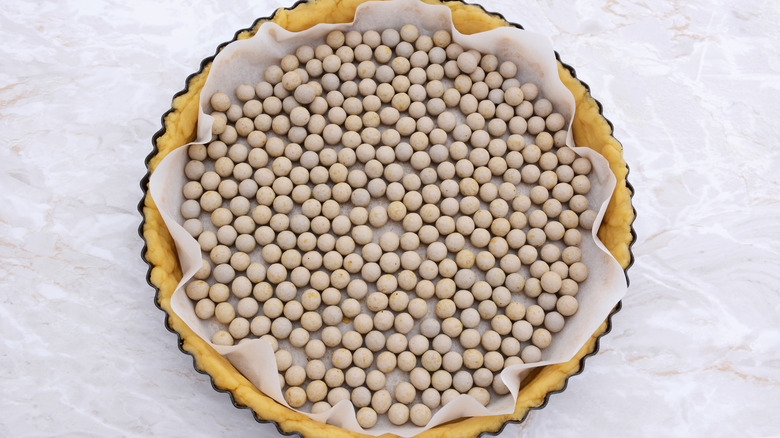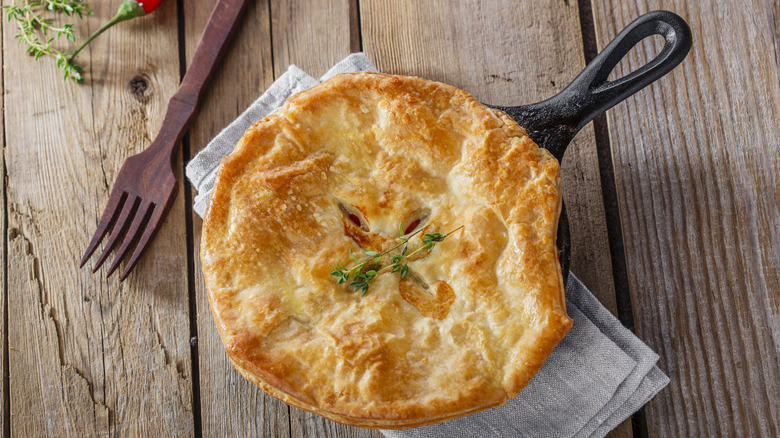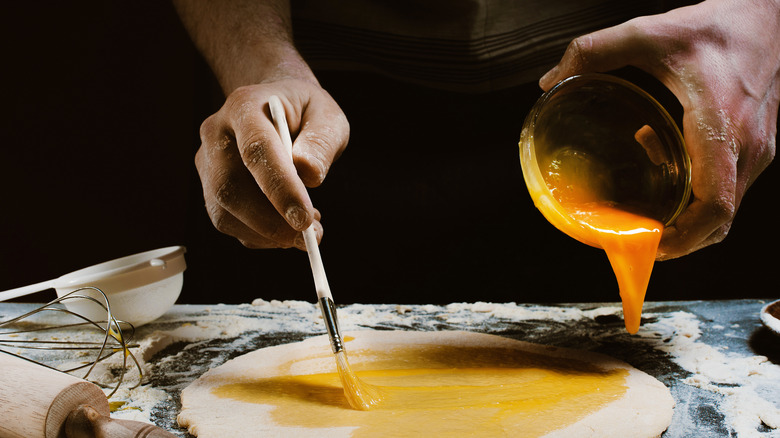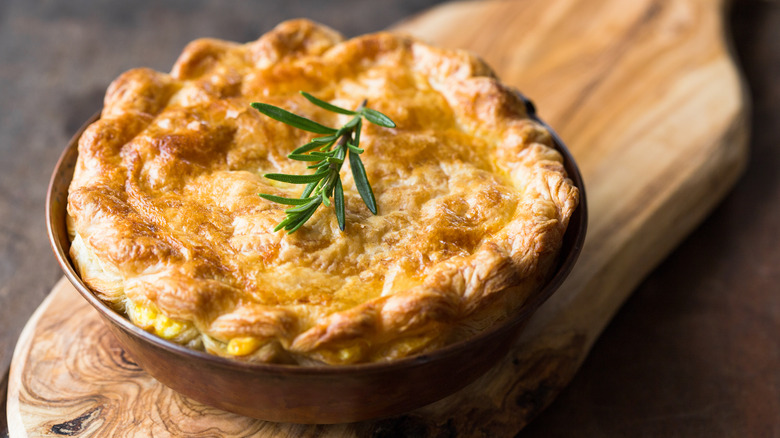Classic Pot Pie Mistakes Everyone Makes
If you're planning a meal for a cozy night at home, you could do much worse than a pot pie. With its flaky crust, hearty filling, and hefty dose of vegetables, it is a complete dinner in one dish that saves you from the hassle of brainstorming side dishes. Chicken pot pie is the most common variation, usually filled with a creamy filling of carrots, peas, potatoes, and other vegetables, but there are many other options if you want to branch out. You can swap the chicken for turkey, lamb, or beef, or make it vegetarian with mushrooms or tofu.
Despite the many excellent qualities of pot pies, however, there is one reason why you might not be rushing to the grocery store to purchase ingredients. Pot pies can be extremely frustrating to make. For the person eating them, there's little downside, since pot pies of any variety are buttery, salty, and comforting. As the cook, however, they pose numerous challenges, from mastering a flaky crust to cooking the meat to perfection to avoid both undercooked health hazards and overcooked toughness. Luckily, cooking is as much of a science as it is an art, and that means there are certain formulas that you can follow to produce the desired outcome. To this end, we've chatted with three chefs from across the culinary spectrum to get the lowdown on the most common mistakes people make with pot pies and how to fix them, once and for all.
Only using butter in the crust
To achieve that mouthwatering flaky texture of classic pie crust, you need to use the right type of fat. Butter, which is the choice of many home cooks due to its availability and familiarity, creates flaky crust because it has a higher water content than other options. As the water heats and evaporates, it makes pockets of air in the dough that become the lamination that is characteristic of a perfectly executed pastry recipe.
In contrast, lard creates flaky crust because of its high melting point. If you use ice-cold lard when you make the dough, it will take longer to melt in the oven than other types of fat. This creates pockets in the crust that lead to layering. Because it's 100% fat, lard also creates a crispier texture.
Many crust recipes call for either all butter or all lard, but Trung Vu, a chef-instructor of Pastry and Baking Arts at the Institute of Culinary Education, prefers a 50/50 ratio. "Butter tastes great," he said, "and although you can make pie dough with butter alone, lard will make it flakier. Lard is a neutral fat (it does not taste like pork, or almost anything, for that matter), so if you were to just use it alone, the pie dough would not be as flavorful. A 50/50 mix of both fats will give you the best of both worlds."
Overworking the dough
Pastry is notoriously difficult to work with. It stretches, breaks, and crumbles when it's too warm and hardens into a rock when it's too cold. If you roll it too thin, it won't make it to the pie dish. If you roll it too thick, it will be soggy and underbaked. Because of these frustrations, you might find yourself laboring over the dough for so long that it goes from freezing cold to warm and soft. You might roll it out and then roll it back into a ball a time or two, trying to achieve the right thickness and shape. And maybe you keep adding flour as it begins to soften. These decisions are an all-too-familiar saga for home cooks, and they can ruin the recipe.
"When you overwork the crust," explained Trung Vu, "[I]t causes more and more gluten formation, which can make it denser and tougher as opposed to the light and flaky quality we love about pie." He suggested mixing the ingredients just until they come together and avoiding reusing dough that has been trimmed off the edges. If you use these trimmings, he warned, "[E]ach successive time you rework that dough will exacerbate the original problem of overdeveloping the gluten." When it comes to pastry, one of the most challenging categories of food you can make, the less you do, the better.
Using uncooked meat and vegetables
Pot pies are baked, so it stands to reason that all the cooking would be done in the oven. But this will almost certainly lead to disappointment in the form of tough vegetables and raw meat. Not cooking the filling can also lead to another issue: soggy crust.
"No matter what protein or vegetables are going into your pot pie, make sure they are already cooked and drained before they go into your filling," Meggan Hill, chef and founder of the food blog Culinary Hill, told us. "By pre-cooking the filling ingredients, you have the chance to prevent both excess fat and water from altering your filling." When you precook the filling, the moisture in the veggies will steam off into the air of your kitchen rather than being trapped inside the pie shell, while the fat in the meat will be drained as soon as you transfer the meat to another pan. One of the upsides of having to double-cook the ingredients, Hill noted, is that it means you can use leftovers in your pot pie. Instead of cooking raw meat and vegetables, why not just mix up the remainder of last night's roast chicken dinner that you have in the fridge? You'll end up with a clean fridge and a delicious meal. It's a win/win.
Using the wrong cut of meat
It's all well and good to cook the ingredients perfectly, but if you aren't using the right ingredients, your pot pie won't have a fighting chance. You can be creative with the vegetables you use, but when it comes to meat, make sure you're using a cut that will be juicy and tender rather than dry and tough. For a beef pot pie, chuck roast (also called beef chuck and chuck steak) will give you the most succulent, buttery filling. With its high fat content, it will melt in your mouth right alongside the creamy veggies.
If you're going the traditional chicken route, you'll find that many recipes call for chicken breast meat or don't specify which cut to use. Although light breast meat might be appealing due to its high protein and low fat content, pot pie is a comfort food, and there's no point making all that buttery crust and creamy sauce only to use a low-calorie cut of meat, especially one that is almost invariably tough when it's cooked. You could use tender, intensely flavored thigh meat, but for the best results, we recommend using a mixture — specifically, an entire chicken. With the skin and combination of light and dark meat, a whole chicken will make your pie extra flavorful and rich. It will also be cheaper than breast meat in most cases. As long as you can spare the added cooking time, using a whole chicken is a no-brainer.
Forgetting to season the filling
In all the agonizing and close monitoring that goes into making the crust and filling, seasoning might seem like the least of your worries. But once you've sealed that pie crust, there's no going back. If you've forgotten to add salt and pepper to the filling, it won't matter how flaky that pastry is or how tender the meat and veggies are: If there's not enough flavor, the results will be severely lacking.
Meggan Hill described seasoning as the most important step in making a pot pie, and one that can easily be overlooked. "No matter what kind of protein or vegetables are going in," she said, "if the sauce itself is bland, the entire casserole will be bland. I recommend that cooks taste the filling after they've made it, add salt, then taste it again." She advised using a trick she learned in culinary school: Find the sweet spot with the salt first, and then add 50% of that amount of pepper.
Another one of Hill's tips is to season the ingredients throughout the cooking process. "When you are pre-cooking your chicken, vegetables, or other filling ingredients," she said, "You'll want to season them in that step. As an example, sprinkling salt on top of the boiled potato isn't the same as boiling a potato in salted water (the latter will infuse the whole potato piece with flavor while it's cooking)."
Cooling the filling
It seems like the tagline to all recipes: Once the item is finished cooking, remove it from the heat and cool. In the case of pot pie filling, however, doing this could lead to a burnt crust or a cold pie. As Meggan Hill explained, "In general, you want to add a warm or hot filling to your pot pie crust. Since the filling is already cooked, you'll only bake the pot pie long enough to cook the crust (whether it is pie crust, puff pastry, or a biscuit topping)." If you chill the filling, it will take longer to heat all the way through than it will for the crust to bake. By the time the center of the filling is hot, the crust will have passed the sweet spot of golden flakiness and crossed into the realm of burnt and crumbly.
While this means that you shouldn't refrigerate your filling in an attempt to chill it to the temperature of, for example, the butter you put in your pastry dough, Hill noted that it should not deter you from making the filling ahead of time. You can simply do it a day or two in advance and then reheat it right before putting it into the pie crust.
Not putting a barrier between the filling and the crust
Perhaps the greatest danger when making any kind of pie is a soggy bottom. Pie fillings need liquid to balance out the dryness of the crust, but you don't want the crust itself to become moist. A soggy crust is as rubbery and unappetizing as raw dough, and it's worth doing everything you can to avoid it. For Emily Laurae, a pastry chef and food blogger, creating a barrier between the crust and the filling is non-negotiable. Even if you add cornstarch to the filling to absorb the moisture, there will still be enough liquid to seep through the filling and saturate the bottom layer of crust. Creating a buffer stops the liquid in its tracks.
Aside from blind baking the crust to ensure it's dry and crispy before the wet filling is added, Laurae suggested "brushing the crust with an egg wash, or sprinkling a thin layer of dry breadcrumbs or grated Parmesan cheese can help absorb excess moisture, maintaining the crust's crispness." Not only do these latter options prevent a soggy bottom, but they'll add an extra kick of delicious flavor and texture.
Overfilling the crust
When you've labored over the filling long enough to produce a creamy, salty extravaganza of flavor, it's only natural that you'd want to pack as much of that concoction into your pie crust as humanly possible without tearing the dough. And yet, doing so will lead to one of the most avoidable and conspicuous baking errors you can make with a pie. As the filling cooks, it starts to bubble, and if it's already bursting at the seams with filling, the bubbling liquid will leak through the ventilation holes that you've made in the top and even through the sealed edges of the pie. Not only will this fill your kitchen with the smell of burning vegetables and meat, and leave you with an unpleasant cleanup job, but it will also make the top of the pie soggy with filling, or worse, encrusted with charred liquid.
To avoid this, you have to limit the amount of filling that you put into the pie. It might feel woefully inadequate, but you should aim to fill the crust just barely above the lip of the pan. The top crust should be relatively flat and should seal easily without having to be stretched. Even if you do manage to restrain yourself from overfilling the crust, however, a little bit of leaking is still possible, so make sure to place the pie on top of a cookie sheet so you won't have to scrub the bottom of your oven afterward.
Not par-baking the crust
One of the most crucial steps to avoiding a soggy-bottomed crust is pre-baking that crust, otherwise known as par-baking or blind baking. Emily Laurae explained that partially cooking the crust before the filling is added "creates a firmer, more cooked-through base that can withstand the moisture from the filling, preventing the dreaded soggy bottom and ensuring a crispier, more enjoyable crust."
You don't have to set aside extra time for this step, as it can be done while you make the filling. Once you made the pastry dough and allowed it to chill in the refrigerator, preheat the oven to 425 degrees Fahrenheit and roll out half the dough. Transfer it to the bottom of the dish you're using, and add pie weights if you have them. The crust only needs to bake for about 15 minutes to become golden brown and crispy. Make sure to cool it completely before adding the filling. Pre-baking the crust might seem like overkill, but trust us, it will yield the flakiest pastry you've ever made and the perfect, impenetrable base for the luxurious filling.
Using a standard pie dish
If you want to make a truly spectacular pot pie with a crisp, golden brown crust, Trung Vu has a surprising suggestion: use a cast iron skillet. You'd think that a pie should automatically be baked in a pie dish, but according to Vu, glass and aluminum pie dishes will not give you the best results. "Cast iron is great at retaining heat," he explained, "and essential if you want a golden-brown crust that stays crisp. If you don't have a cast iron pan, a dark-colored pan is preferable to a light-colored one, as it will absorb heat more efficiently." In contrast, he continued, glass and aluminum do not retain heat as readily because they are light in color.
Even if you don't have a cast iron skillet, however, Vu has a trick that will ensure a crispy bottomed crust. "If the bottom crust is not as dark as you'd prefer," he said, "try cooking it on the stovetop over low heat (if using a glass or ceramic pan, be sure to check that it can be used on direct heat), turning and monitoring it carefully until it reaches the desired color."
Forgetting the egg wash
Making a pot pie from scratch is impressive enough, especially if you manage to nail all the flavors and textures. But if you really want to show off, you have to use an egg wash. The good news is that, unlike the rest of the pie, it's quick and easy to do. Egg washes give the crust a glossy, golden brown finish that looks professional and irresistibly delicious through something known as the Maillard Reaction. This magical process is what we have to thank for the color and texture of everything from toast to seared meat, and happens when high temperature is applied to proteins and sugars, such as those that are naturally found in eggs.
There is a surprising number of options when it comes to egg washes. One of the most popular is an egg whisked with milk or cream. The fat in the dairy increases the glossiness and adds a hint of flavor. For a darker color, you can omit the water or even the white and use just the yolk. If you choose this option, make sure to check the oven occasionally, as egg-only options have a habit of burning. If you aren't particularly interested in browning the crust but want that glossy shine, opt for an egg white instead. It will give you an eye-catching sheen without noticeably darkening the crust. Whichever option you choose, make sure to whisk it thoroughly to avoid strands of egg that will quickly burn.
Not letting the pie rest
One of the most avoidable mistakes is cutting into the pie the minute you pull it out of the oven. We get it. Once the aroma of golden brown pastry and creamy chicken filling pervades your kitchen, you want to dig in right away, and letting it sit on the counter for 20 minutes feels like an unnecessary form of punishment that you don't deserve. But according to Emily Laurae, there are some pretty solid reasons for restraining yourself.
"Letting the pot pie rest before serving is vital for two reasons," she explained. For one thing, "it allows the filling to set, preventing it from spilling out when cut." The visual appeal of the dish is almost as important as its flavor, and having a pie that holds its shape is a sign of real baking artistry. Secondly, Laurae explained that letting the pie sit actually enhances its flavors.
So there you have it. Letting the pie sit (Laurae recommends 15 to 30 minutes) will make it even more flavorful than your watering taste buds are imagining.
